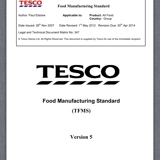Information
-
Document No.
-
Audit Title
-
Client / Site
-
Conducted on
-
Prepared by
-
Location
-
Personnel
13.1 - ALLERGEN COP (BASE)
-
All Sites must comply with the requirements as detailed in Tesco Code of Practise 376 - Allergen control
13.1.2 - ALLERGEN CONTROLS (BASE)
-
Allergens must be risk assessed individually, no grouping or hierarchy
-
Where allergens are used or stored the risk assessment must establish the potential for cross contamination
-
The risk assessment must include all processes and areas of the factory, including product transfer
-
If the risk assessment forms part of the HACCP it will need to be clearly documented
-
The risk assessment considers; (Not exhaustive list)
-
Transfer and movement of used equipment
-
Process aids
-
Cleaning
-
CIP
-
Product development
13.2 - SPECIFICATIONS (BASE)
-
Raw material specifications must detail all Tesco recognised allergens handled on site.
-
The specification must provide detail of the risk of cross contamination
13.2.1 - TRANSPORT OF RAW MATERIALS (BASE)
-
Transport of raw material must not pose a risk of cross contamination
-
Bulk tankers used for both allergenic and non allergenic raw materials must be able to produce cleaning records
-
Consideration is given to vehicle loading / unloading and cleaning
13.3 - CROSS CONTAMINATION (MEDIUM)
-
Open product that has been in contact with allergenic material must be disposed of if not being used in like for like product
13.4 - STORAGE (BASE)
-
Segregation of allergens must be based on risk assessment (I.e. Product in unopened / fully sealed packaging poses less risk that packaging that has been open and re-sealed or open / covered products)
-
Allergenic materials stored on pallets at floor level to minimise the risk of cross contamination if damaged
13.5 - IDENTIFICATION (BASE)
-
Based on risk assessment raw materials, work in progress and finished product containing allergens must be clearly identified during storage and production
13.6 - EQUIPMENT CLEANING (BASE)
-
Cleaning between the production of allergen and non-allergen containing products and products containing different allergens must be thorough, and where possible chemically cleaned to remove all visible debris
-
Where tests are readily available, the cleaning procedures may be validated with surface allergen testing kits
-
The cleaning must be verified by documented visual inspections as a minimum
-
Consideration should also be given to cleaning of the environment (e.g. Splashing to walls and ceilings) where there is an obvious risk
-
A validation study must be available and reviewed annually or after any change in huge equipment or procedures
13.6.1 - EQUIPMENT CLEANING (BASE)
-
Sieves must be dedicated to individual allergenic ingredients or cleaned immediately after allergenic material is sieved, where there is a risk of cross contamination.
-
Bulk or inline sieving equipment must be cleaned to remove all visible derisory
-
Where fitted, extraction equipment must be suitably cleaned and managed to prevent any risk of cross contamination
13.7 - EQUIPMENT (BASE)
-
Utensils used for handling allergen products must be chemically cleaned after use or dedicated to specific ingredients
-
Stainless steel is preferred as it's easier to clean than acrylic equipment which can become heavily scored over time
13.7.1 - MAINTENANCE (BASE)
-
Maintenance activities on equipment handling allergens must be risk assessed and appropriate controls defined and implemented
-
Movement of engineers and tools from one machine to another must be considered<br>
13.8 - SEGREGATION (BASE)
-
If dedicated lines (for allergens) are not in place, scheduling must take into consideration the allergen content of the different products produced on the line
-
Line cleaning and other controls must be employed as determined necessary by risk assessment
13.8.1 - SEGREGATION (ASPIRATIONAL)
-
Products containing allergens are produced on dedicated equipment, lines or facilities
13.9 - REWORK (BASE)
-
Rework that contains allergenic ingredients must be reworked only into products that contain that allergen
13.10 - REWORK (BASE)
-
Not applicable
13.11 - SPILLAGE (BASE)
-
Any spillage of allergenic material that occurs during production, storage or distribution must be cleaned up immediately to ensure no risk of cross contamination
13.12 - PERSONNEL (BASE)
-
All staff (including agency) must receive allergen training as part of the site induction
-
Where allergens are used, staff must be aware of the risks regarding cross contamination
13.12.1 - PERSONNEL (MEDIUM)
-
Based on risk assessment personnel manufacturing allergenic product must be clearly identifiable <br>e.g. Through wearing / using coloured disposable protective equipment














